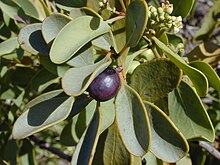Santalaceae
| Santalaceae | |
|---|---|

| |
| Santalum ellipticum | |
| Scientific classification | |
| Kingdom: | Plantae |
| Clade: | Tracheophytes |
| Clade: | Angiosperms |
| Clade: | Eudicots |
| Order: | Santalales |
| Family: | Santalaceae R.Br. |
The Santalaceae, sandalwoods, are a widely distributed family of flowering plants (including small trees, shrubs, perennial herbs, and epiphytic climbers[1]) which, like other members of Santalales, are partially parasitic on other plants. Its flowers are bisexual or, by abortion ("flower drop"), unisexual.[2] Modern treatments of the Santalaceae include the family Viscaceae (mistletoes), previously considered distinct.
The APG II system of 2003 recognises the family and assigns it to the order Santalales in the clade core eudicots. However, the circumscription by APG is much wider than accepted by previous classifications, including the plants earlier treated in families Eremolepidaceae and Viscaceae. It includes about 1,000 species in 43 genera.[3] Many have reported traditional and cultural uses, including as medicine.[4]
Genera
- Acanthosyris
- Amphorogyne
- Anthobolus
- Antidaphne (previously Eremolepidaceae)
- Arceuthobium (previously Viscaceae)
- Buckleya
- Cervantesia Ruiz & Pavón
- Choretrum R.Br.
- Cladomyza
- Comandra Nutt.
- Daenikera
- Dendromyza[1]
- Dendrophthora (previously Viscaceae)
- Dendrotrophe
- Dufrenoya
- Elaphanthera
- Eubrachion (previously Eremolepidaceae)
- Exocarpos Pers.[1]
- Geocaulon
- Ginalloa (previously Viscaceae)
- Henslowia
- Jodina
- Korthalsella Tiegh.
- Kunkeliella
- Lepidoceras (previously Eremolepidaceae)
- Leptomeria
- Mida
- Myoschilos
- Nanodea
- Nestronia
- Notothixos (previously Viscaceae)
- Okoubaka Pellegr. & Normand
- Omphacomeria
- Osyridicarpos
- Osyris
- Phacellaria
- Phoradendron Nutt. (previously Viscaceae)
- Pilgerina Z.S.Rogers, Nickrent & Malécot
- Pyrularia
- Rhoiacarpos
- Santalum L.
- Scleropyrum
- Spirogardnera
- Staufferia
- Thesidium
- Thesium L.
- Viscum L. (previously Viscaceae)
excluded genera:
- Arjona - to Schoepfiaceae
- Quinchamalium - to Schoepfiaceae
References
- ^ a b c Hewson & George [et al.], Santalaceae taxonomy Archived 2015-03-24 at the Wayback Machine, 1984, pp. 191-194.
- ^ Pilger, R. Santalaceae (with 17 figures). R. Br. Prodr. Fl. Nov. Holl. (1810) 350, pp. 1-45.
- ^ Christenhusz, M. J. M. & Byng, J. W. (2016). "The number of known plants species in the world and its annual increase". Phytotaxa. 261 (3). Magnolia Press: 201–217. doi:10.11646/phytotaxa.261.3.1.
- ^ O'Neill, A. R.; Rana, S. K. (2019). "An ethnobotanical analysis of parasitic plants (Parijibi) in the Nepal Himalaya". Journal of Ethnobiology and Ethnomedicine. 12 (14): 14. doi:10.1186/s13002-016-0086-y. PMC 4765049. PMID 26912113.
External links
- Parasitic Plant Connection web site: Amphorogynaceae
- Parasitic Plant Connection web site: Cervantesiaceae
- Parasitic Plant Connection web site: Comandraceae
- Parasitic Plant Connection web site: Nanodeaceae
- Parasitic Plant Connection web site: Santalaceae s. str.
- Parasitic Plant Connection web site: Thesiaceae
- Parasitic Plant Connection web site: Viscaceae
